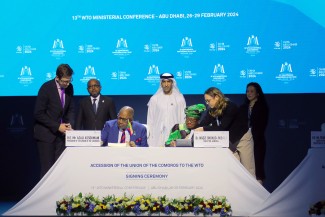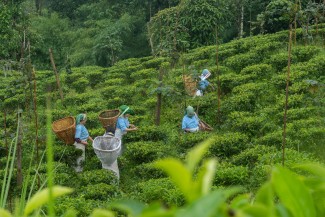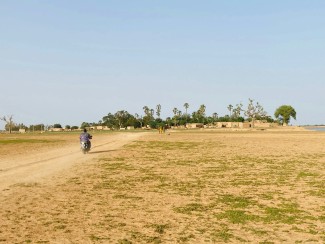|
|
Despite longstanding recognition of the benefits of trade and the importance of improving competitiveness, Africa is performing beneath its potential in global and regional agricultural markets.
Recent export growth has been offset by even larger growth in imports, caused by a booming population. This has led to a deterioration of Africa’s trade balance. Intraregional trade, on the other hand, is growing, but remains significantly below the levels seen in other parts of the world.
The recently released Africa Agriculture Trade Monitor (AATM) 2019 report offers detailed assessments of recent trends in Africa’s trade performance and competitiveness at regional and continental levels, as well as investigations of the relative importance of different drivers and constraints. Africa’s challenges result from a host of factors, including historical trends and more recent developments both within and beyond the continent, and action is needed on many fronts to alleviate these constraints and improve competitiveness.
Greater and more diversified agricultural trade at regional and global levels could help boost productivity at all stages along the value chain, thereby helping to transform African agriculture into a high-productivity sector, provide adequate incomes and stimulate growth.
Increasing agricultural trade also has the potential to improve food security and contribute to stabilizing local and regional food markets by making them less vulnerable to shocks.
GOOD TIDINGS
The AATM includes both good and bad news for African agriculture. The good news is:
1) Africa’s share of world agricultural GDP and world agricultural trade has increased.Between 2005–2017, Africa’s share of world GDP went from 2.6% to 3.0%. For agriculture, Africa’s share increased from 10% in 2005 to 12% in 2017.
2) Africa has strong comparative advantages in some products. This includes traditional cash crops like coffee, cocoa and tea, as well as new products like legumes, pulses and sesame seeds that are important to many African countries, including least developed country (LDC) economies like Burkina Faso, Chad, Ethiopia, Niger, Togo and South Sudan.
3) Market share analysis shows that African agriculture has strong adaptation capacity. Many countries have seen their world market share in agriculture increase over the last 10 years.
Thirty-one have increased that market share, with the largest absolute gains for Algeria, Côte d’Ivoire, Egypt, Ghana, Morocco and Nigeria, and the LDC countries of Benin, Ethiopia, Guinea-Bissau, Madagascar, Mozambique, Rwanda, Senegal, Somalia, Tanzania and Uganda.
As to the report’s other findings:
1) There is a lack of product diversification on the export side. There are low levels of agricultural export diversification in all African countries that are dependent on a small number of commodities. The low Global Sectoral Diversification Index (GSDI) of exports shows that most countries export some commodities that are not exported much by the rest of the world.
The left graphic displays the average number of equivalent sectoral markets, and the right graphic displays the average Global Sectoral Diversification Index (GSDI) over 2016-2017.
2) African exports are dominated by primary exports. To foster agricultural transformation, it is essential that African countries develop their agribusiness sectors to diversify exports and develop comparative advantages beyond the primary stage of production.
REALLOCATION AND SPECIALIZATION
The report examines African export performance by studying each country’s and each regional economic community’s contribution with their geographical or sectoral specialization. For example, if they benefit from an outstanding export growth trend due to the product that it exports and/or the destination of these exports. So exporting agricultural products to China is beneficial because Chinese demand for imports has been particularly sustained during the period.
Moreover, the report evaluates what comes from an initial pattern of specialization, and what comes from a reallocation of exports to specific products or specific destinations over the period.
Geographical reallocation has benefitted 27 countries, and notably four LDCs. Niger has increased its export shares to China, Malaysia and Thailand; Angola to Chile, China and Peru; Somalia to Gulf countries like Oman and Saudi Arabia, and China; and Liberia to Malaysia and the Netherlands.
Sixteen countries, on the other hand, have seen their export performance undermined by negative reallocation. The effect is still limited, but has had noticeable impact on Eritrea with a reduction in export share to Europe and the United States in favor of Egypt; Benin and Burkina Faso with reallocation from China and Thailand to India and Vietnam; and East African countries such as Rwanda and Burundi that strengthened trade with regional partners with limited import demand.
Niger has increased its export shares to China, Malaysia and Thailand; Angola to Chile, China and Peru; Somalia to Gulf countries like Oman and Saudi Arabia, and China; and Liberia to Malaysia and the Netherlands.
Africa Agriculture Trade Monitor 2019
Sectoral specialization is also an important factor that affected trade development. Thirty-three African economies had a pro-agricultural trade growth specialization pattern, including LDCs like Comoros with its focus on spices and essential oils; Burundi and its focus on coffee, tea and beer; Rwanda with coffee and tea; and Guinea with cocoa and coffee.
The AATM report found that 19 economies were in the reverse situation, the most impacted being the cotton-focused economies of Chad, Burkina Faso, Benin and Mali. But, drawn by growing demand, the vast majority of African economies increased their export shares in pro-growth products like spices, vanilla, sesame seeds and groundnuts.
INTRA- AND EXTRA-AFRICAN TRADE
The current export structure of African countries illustrates the lack of progress along value chains. Of the US$62 billion in agricultural products exported by Africa in 2017, only US$12 billion are classified as processed goods. While total exports increased between 2005-2017, the relative role of processed and unprocessed products has not evolved.
But there is a very distinct pattern between intra-Africa trade and extra-Africa trade.
While African exports to non-African markets are dominated (90%) by primary or semi-processed products, the situation with regional markets is balanced, meaning half of intraregional trade is associated with processed products. This is relatively important in the context of increased regional trade following the Malabo Declaration, which commits to tripling intra-Africa trade, and the implementation of the AfCFTA.
Regional markets within Africa tend to have many similarities in terms of consumer preferences and legislation, and are easier markets to penetrate, especially for small and medium enterprises. But, demand for primary cash crops within Africa remains limited owing to similar production patterns and the lack of large-scale processing facilities, so most primary commodities such as cocoa, coffee, cotton and tea are produced only for world markets.
Non-tariff measures such as sanitary and phytosanitary regulations; technical regulations, for example with package labelling; and specific rules of origin may remain barriers to diversification. Since these issues are key elements of the AfCFTA negotiations, it is expected that these barriers may be removed at the continental level relatively soon, strengthening the case for expanding the share of processed products in regional trade.
Header image of an agri-food processing plant in Ethiopia - ©Fernando Castro/EIF
If you would like to reuse any material published here, please let us know by sending an email to EIF Communications: eifcommunications@wto.org.




